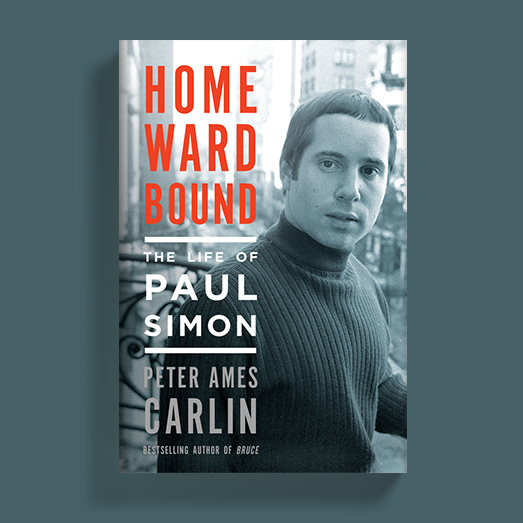By Peter Ames Carlin
Chapter 1
Real and Assumed
On February 16, 1967, Paul Simon sat at a conference table in his lawyers' offices and tried to explain who he was, who he used to be, and who he had become. This would take some doing.
For while he was clearly Paul Frederic Simon, born in Newark, New Jersey, on October 13, 1941, the elder of the two sons whom Louis and Belle Simon raised in the Kew Gardens Hills section of Queens, New York, he had answered to several other names in his twenty-five years. All in the pursuit of a professional music career that took off a few weeks into his senior year of high school, when the short, dark-eyed Simon, along with his tall, blue-eyed best friend, Arthur "Artie" Garfunkel, recorded "Hey, Schoolgirl," a sprightly pop tune of their own composition. The owner of a small New York record company heard cash register bells in the boys' chiming harmonies, and within days he had their signatures on a recording contract.
The boys waxed another song for the single's B-side and then set to inventing a catchy stage name for their act. Anything to differentiate themselves from the hundreds, even thousands, of artists lobbing songs at the Billboard charts that week. There were other reasons, particularly their obviously ethnic names, so when record company owner Sid Prosen came up with Tom and Jerry, which played off the popular cartoon characters of the day, Artie and Paul added surnames (Graph and Landis, respectively) and crossed their fingers. Mirabile dictu, and by Thanksgiving "Hey, Schoolgirl" was hopscotching up the sales charts. By the end of Christmas vacation Paul and Artie's shiny-cheeked alter egos were famous. TEEN SONGWRITERS HIT, shouted the New York World-Telegram and Sun, WHIZ KIDS ROCK 'N' ROLL! cried the Long Island Star-Journal.
The glory didn't last. Tom and Jerry recorded and released eight or so other songs in the next few months, but none of them followed the astral trajectory of "Schoolgirl." With college on the horizon and a bitter disagreement already in progress, the duo retired from the Tom and Jerry business and stepped back onto the middle-class overachievers' path to college, graduate school, and the 7:04 from Scarsdale to Grand Central. That didn't last, either, and when the pair re-reformed as folksingers in 1963, it took just over two years for them to become extremely, wildly, imprinted-upon-a-generation famous as Simon and Garfunkel. One year and a chain of folk-rock hits later, the pop tunes by 1950s teen idols Tom and Jerry reappeared in a package decorated with the grown-up Simon and Garfunkel's poet-rocker frowns--and this was a big problem.
Tom and Jerry had been light-footed teen idols whose central, nay, sole concerns involved girls, school, the joys of the former, the hassles of the latter, and the travails of both. They were the boys every mother wanted her daughter to bring home. But a decade later Simon and Garfunkel were stylish folksingers whose melancholic songs surveyed the internal geographies of postadolescent malaise, social disconnection, and the euphoria that grabs you when the sun shines and you're rapping with lampposts and feeling groovy. So how could Prosen have compiled those ridiculous high school songs, slapped a recent photo on the cover, and called it Simon and Garfunkel's latest album? Outraged by the potential damage the bogus album could cause their reputations and fortunes, Paul and Artie had summoned their attorneys and gone on the attack.
The argument boiled down to this: While the original contract the adolescent Paul and Artie and their parents had signed with Prosen in 1957 did grant the executive the right to use their master recordings in any fashion he chose, nothing in the deal gave him the right to advertise the work as the product of Paul Simon and Arthur Garfunkel. Back when they signed, Paul and Artie were unknown high schoolers who were thrilled to get any attention whatsoever. If "Tom and Jerry" was a more marketable handle than "Artie and Paul," then so be it; pop stars always changed their names. Yet when their debut record made a splash, virtually every feature written about the teen duo, in newspapers ranging from the Forest Hills High School Beacon to the New York World-Telegram and Sun to the Long Island Star-Journal, revealed some combination of the boys' real names, the names of their parents, and the exact name and location of their high school. And they were thrilled. They wanted everyone to know who they were and that they were now pop stars. It was the greatest thing that had ever happened to them!
Sign up for more essays, interviews and excerpts from Thought Matters.
ThoughtMatters is a partnership between Macmillan Publishers and Huffington Post
Or so it seemed until late 1965, when the older and more sophisticated pair hit the top of Billboard's Hot 100 with "The Sound of Silence." In the era of Dylan and dissent, when musicians who mattered were expected to be not just artists but also activists, generational spokesmen, and something like sages, a song like "Hey, Schoolgirl" could be a career ender. In their complaint to the New York State Supreme Court, their statements are a pastiche of rage, legalese, and Blanche DuBois. The belated appearance of the Tom and Jerry album was a moral, ethical, and economic travesty: Unfair competition. Unlawful trade. A violation of privacy. An unlawful appropriation of the plaintiffs' duly established trade name, "Simon and Garfunkel."* As Prosen had learned in 1958 and as future defendants and/or aspiring plaintiffs would later discover, Paul Simon wouldn't stand for anything that struck him as a violation of his personal, professional, or economic property. He drew lines and constructed barricades around himself, particularly when it came to defining who he was. So Paul wanted everyone to get this straight. Even if Paul and Artie had been Tom and Jerry, Tom and Jerry had never really been Paul and Artie. And there were others, too--True Taylor, Paul Kane. The existence and the limitations of Paul's alter egos would be courtroom fodder for many years.
This time, the court would rule quickly in Simon and Garfunkel's favor. Most every copy of Prosen's wayward LP would spend eternity at the bottom of a landfill in New Jersey or Ohio. Still, if the courtroom victory ensured Simon and Garfunkel a clear path to their future, it did little to ease the ache in Paul's muscled chest--the vivid glare of his failings, the dismay of matching eyes with the stumpy, prematurely balding creature in the mirror.
And yet millions of people adored Paul. At twenty-five, he was already phenomenally successful: a hit songwriter and performer whose popularity—Simon and Garfunkel's most recent album had sold three million copies, peaking at No. 4 on the Billboard charts—was rivaled only by the critical acclaim that greeted his work. Critics evaluated his songs in terms of poetry and musical innovation. Editorialists interpreted his thoughts as social commentary, statements from the heart of the surging, seething New Generation. Four years out of Queens College, three years after dropping out of Brooklyn Law School, Paul Simon had made himself into one of the most influential voices in Western popular culture. Yet his father, a former professional musician who had remade himself into an educator, couldn't stop telling his famous son that he was wasting his life.
Paul was accustomed to not measuring up—not physically, given his tiny build and humble facial features; not musically, given his relatively thin singing voice; and not in heritage, due to being the scion of Jewish immigrants growing up in the midst of a largely anti-Semitic culture. And yet no criticism could rival his own unsparing judgment of himself: the standards he could rarely meet, the shame that would plague him after he had taken pleasure in achieving something that made him feel proud. He felt like a phony, and accused others of being the same: Dylan, with his fictional past and bogus name; Artie, Paul's tall, blond, golden-voiced brother in music, for being called a sex symbol. How, Paul asked, could there be a sex symbol named Garfunkel? Even while dressing himself in velvet and adding a cape, wraparound sunglasses, and elegant high-heeled boots, he swore he was finished with music and stardom. He'd stick it out another few months, maybe a year, he said, and then abandon the whole enterprise. No more shows, no more records, no more songs. He'd always wanted to be a novelist anyway. "I enjoy singing and rock and roll, but the main thing I want to do is write. That's what I'm living for in between performances. I'm always writing, trying to develop characters so that I can do the Great American Novel." Even in the spring of 1966, in the middle of his first great rush of success, the impulse to be something else, not to settle for whatever or whoever he was at that moment.
Then Paul got writer's block, a months-long spell of creative paralysis that finally ended when he sensed a few chords gathering around him and teased out a thread of melody that led to a vision of a watery fellow sitting alone in the gloom of his manse—a man out of place not just in his home but also in his own skin. His girlfriend lives by her own inscrutable whims. He can barely leave the house, thanks both to the grabby vines in his garden and his skim milk constitution. Even he knows how sad a vision he truly is. "I know I'm fakin' it," he says. "Not really makin' it." Then something happens. He has a vision of himself in an earlier life: not as a washed-out member of the landed gentry, but as a shopkeeper; a man of cotton, silk, wool, and bone; a skilled creator of necessary goods, the garments that keep you warm, dry, and healthy even in the worst of conditions. "A tailor!"—a valued, even beloved, member of his community. And it's a revelation: "I have the tailor's face and hands!" he cries. "I have the tailor's face and hands!"
Recorded in June 1967, "Fakin' It" was released as a single in early July 1968 and became a moderate hit, peaking at No. 23 on Billboard's Hot 100. Paul said later that he was astonished to learn that he was in fact the descendant of a tailor, a tailor who was also named Paul Simon. Simon the elder learned his trade back in the Old World, and brought it with him to the new one at the dawn of the twentieth century, working first in New York City and then crossing the Hudson River to start his own business in Newark, New Jersey. There he made a home and raised his family to be real Americans—smart, ambitious, and hardworking, their eyes locked so securely on the future that it took only two generations for his descendants to forget, or at least pretend not to remember, that he ever existed.
*The affidavit puts the quotation marks around "Simon and Garfunkel," emphasizing that their surnames constitute a duly established trade name. An attorney for Prosen's side responded: "I know of no precedent in which one would call his own legal family name an assumed name."
Copyright © 2016 by Peter Ames Carlin

PETER AMES CARLIN is a writer and the author of several books, including Bruce, a biography of Bruce Springsteen published in October, 2012. Carlin has also been a free-lance journalist, a senior writer at People in New York City, and a television columnist and feature writer at The Oregonian in Portland. A regular speaker on music, art and popular culture, Carlin lives in Portland, Ore., with his wife and three children.
Read more at Thought Matters. Sign up for originals essays, interviews, and excerpts from some of the most influential minds of our age.

